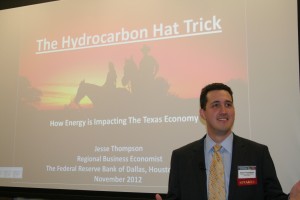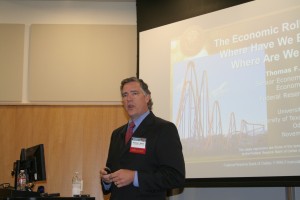The numbers out of Texas tell a story of economic prosperity. Number One exporting state. Extremely low unemployment rate. A leader in oil and gas production. In a presentation where seldom was heard a discouraging word, about the only washout was the state’s 40-year low in the numbers of cattle—a decline attributable to the extended drought.
“The Economy Today and Tomorrow” was presented November 15 by the Federal Reserve Bank of Dallas—El Paso Branch and the University of Texas of the Permian Basin. Economists from the Federal Reserve Bank of Dallas talked to more than 100 business people, educators, and college students at UTPB about the strength of the U.S. economy today, regional economy and energy markets, Mexico and the border region, and global economic recovery.
Boosting the state’s economic numbers is the hydrocarbon industry. And while it also puts Texas among the leaders when compared to the world economy, the state’s figures could drop as world markets struggle with recession.
In the past few years, the Fed has sent its economists to different cities in their regions to communicate the role the central bank plays in the country’s economy and how people can plan ahead. Odessan Kirk Edwards, a member of the Fed’s Dallas board, said the seminars “help people better understand where the economy has been and where it’s going. Attendees can use data from the Feds and gain a better forecast on what they think the economy will do.”
While Texas seemed to be the shining star in the global sky, Edwards noted that a weak world economy will impact Texas in the form of lower oil prices and demand for hydrocarbon resources.
“The U.S. is on a slow increase but we are still very dependent on other factors in the world. The biggest one on the horizon is Europe,” he said.
The Fed, noted speaker Lupe M. Edens, is “the bankers’ bank. We get the money direct from the printer.” It influences the monetary policy, supervises financial institutions, and offers financial services.
Before determining the country’s monetary policy, the Fed assesses economic data from across the country and around the world. That was the information the Fed team highlighted during its Permian Basin visit.
The state’s recent economic upward curve is due to the “shale revolution,” business economist Jesse Thompson of the Fed’s Houston branch said. “That is a mild term. It doesn’t convey how significant a break it is with past markets.”
In previous years, the price of oil and gas seemed to move up and down together. However, when the Great Recession (as the Fed economists referred to the 2008 downturn) hit, the price of gas didn’t bounce back as fast as oil.
“The reason is shale,” Thompson said. “We found out how to use fracking and horizontal drilling to extract this oil and gas.” The winter of 2011 was mild, demand for gas went down, and the price dropped to the $3-4 range. “There is an oversupply of gas and gas liquids,” he said.
Meanwhile, the price of oil went up. Thompson noted there are 77 percent more oil rigs in use today. “The low natural gas prices have made it unfeasible to drill for gas,” said the author of the monthly Houston Economic Update.
Drilling in the Barnett Shale started in 2004 to get gas out of the ground. With low natural gas prices, the rigs are being moved out of the Barnett to other areas like the Eagle Ford, which yields natural gas liquids that include ethane, propane, and butane and are utilized to manufacture other products. That means the labor supply is also moving to the Eagle Ford and the Permian Basin, which is focusing on oil.
Drilling in the Spraberry and Wolfberry has generated a labor supply shortage in the Permian Basin, acknowledged Thompson. The growth in drilling and production halted a 20-year drop in production, prompting some people to forecast the U.S. will become the No. 1 producer of energy within 20 years.
The boom in energy has translated into an increase in the state’s severance tax by 61 percent to $1.8 billion, and a sales tax increase in energy equipment of 10.1 percent.
“The retail sales in energy in the Eagle Ford generated $312 million in state taxes,” Thompson said.
Every aspect of the industry is impacted by the increased drilling. Once the hydrocarbons are extracted from the ground, it has to be transported to market and that calls for more pipelines and refineries. Even with the existing pipeline infrastructure in the Permian Basin, the takeaway capacity is insufficient, he noted. Companies that manufacture pipes and fittings for the midstream market are growing. Gulf Coast refineries are operating at 90 to 95 percent capacity.
With U.S. consumption of gasoline down, the U.S. has become a net exporter of diesel and gasoline to countries where more people are able to afford cars, according to Thompson.
He was asked if the United States could become energy independent in the next 20 years and the economist replied, “Global demand will trump our expectations. Even if everyone takes the bus, it doesn’t matter. It is a global commodity. Our ability to export and be integrated into the global economy helps us capitalize on the benefits.”
Oil and natural gas are not the only commodities being sought on the world market. Natural gas byproducts, including ethane, ethylene, and naphtha are exported. Ethane is used to produce ethylene, which is the dominant chemical used to produce plastics. According to Wikipedia, naphtha also has numerous applications, including its use as a component of lighter fluid, as fuel for camp stoves, and as an agent in some cleaning solvents. Thompson noted it is a globally traded product.
“Texas will see growth in refineries to produce ethylene. We’re building a lot of chemical plants; it’s a high-dollar industry. And it will take thousands of highly skilled individuals to work there. Those people are key. Skilled labor benefits Texas,” Thompson said.
He predicted the price of oil next year will stay above $80/barrel. “With oil at that price there are very few potential drill sites you can’t justify,” he said. “If it goes above $100, that’s gravy.”
However, finding skilled labor “who can pass a drug test” to operate those technologically improved rigs is the hurdle. Others include a slowing global economy which means fewer exports for the United States, and increasing regulation of the petroleum industry. Meanwhile, Texas employment should grow by 2.1 percent next year.
The hydrocarbon industry has helped hoist the United States out of what economists term the Great Recession that started in late 2008. Thomas F. Siems, senior economist and director of economic outreach for the Fed in Dallas, said this recent recession has been the deepest since 1929 and the end of World War II. “During a recovery, economic growth should be more than 3 percent,” Siems said.
“The 2008 recession started out on a typical curve, then it took a nosedive. It bottomed out in 2009 but the bounce back has not been robust. It is not keeping up with our 3 percent growth,” he said and attributed the reason to a lackluster jobs market. “We’ve only gained back half those jobs. We are seven years behind in jobs and we won’t get back to that peak point we had in 2007 until 2015.”
One reason is the U.S. jobs market has changed, Siems noted. “We call this a jobless recovery because of outsourcing and the fact that the types of jobs have changed and will continue to change. People with the right education in the right fields will get the jobs.” Among the college educated working population, there is a 4.5 percent jobless rate. High school dropouts, though, fall into the 15 percent unemployment category.
Consumers comprise the main driver of economic recovery. But when they don’t have jobs, they aren’t buying things. While the 1980s was known as the decade of conspicuous consumption, the trend reversed when the economy dipped in 2008.
“This Great Recession is the deepest and longest in more than 60 years,” Siems said. “It was preceded by over-consumption, over-building, and excessive debt.
While banks are struggling in other parts of the country, Texas banks have weathered this economic storm—unlike the tumults of the late 1980s when 133 banks were closed in the state.
Siems pointed to charts revealing Texas’ rank as number one in job creation in the country. Compared to the rest of the world, the state still ranks in the top spot, with Australia in second place. Japan was at the bottom. “More new businesses have been created in Texas than anywhere else,” he said.
With a growth rate prediction of 2 to 2.5 percent this year and next for the United States—a rate that is considered slow—the bond rates, as Siems pointed out, stands at 1.81 percent in the United States, as compared to 18.09 in Greece. It’s a disparity that entices investors to put their money into this country.
Slowing that growth below 2 percent could be a force called “headwinds,” which Siems said include the European debt crisis and recession, extended joblessness, uneven housing recovery, and the U.S. national debt. “We have to get a handle on our government spending now, while the rates are low and inflation is down.”
Even Mexico, which is the number one consumer for Texas products, could be recovering faster than the United States, according to Roberto Coronado, assistant vice president in charge and senior economist with the El Paso Branch of the Fed. Once the Central Bank of Mexico was established to keep inflation under control and maintain price stability, Mexico’s economy began to stabilize.
“Mexico is having a strong recovery compared to the United States,” he said. “Capital inflows are making a strong comeback. Challenging Mexico’s recovery are the U.S. sluggish economy, overheating in the energy markets, and the impact of violence in the country on investments.” The depth of the financial sector is another hurdle as people encounter difficulties in getting home remodeling loans.
The world, though, still plays a major role in the U.S. economy, noted Scott Davis, research economist with the Fed in Dallas. “The outlook of the global economy depends on what happens in Europe,” he said. Parts of Europe, such as Greece and Spain, are still in recession. From these periphery countries the economic malaise is spreading to the European core.
“European countries are not buying as much, so other countries in the world are seeing their exports to Europe fall,” he said. The BRIC countries—the emerging markets of Brazil, Russia, India, and China—had helped power the rest of the world out of the recent crisis. But they, too, are facing recession now.
“The U.S. is the only major economy in expansion mode,” Davis said. The unemployment rate in the U.S. is dropping some while it’s rising in Europe. The U.S. stock market has grown over the past two years, as have the energy markets.
Davis expressed some optimism about Europe’s future, saying that wages are falling in some countries and this will make them more competitive.











